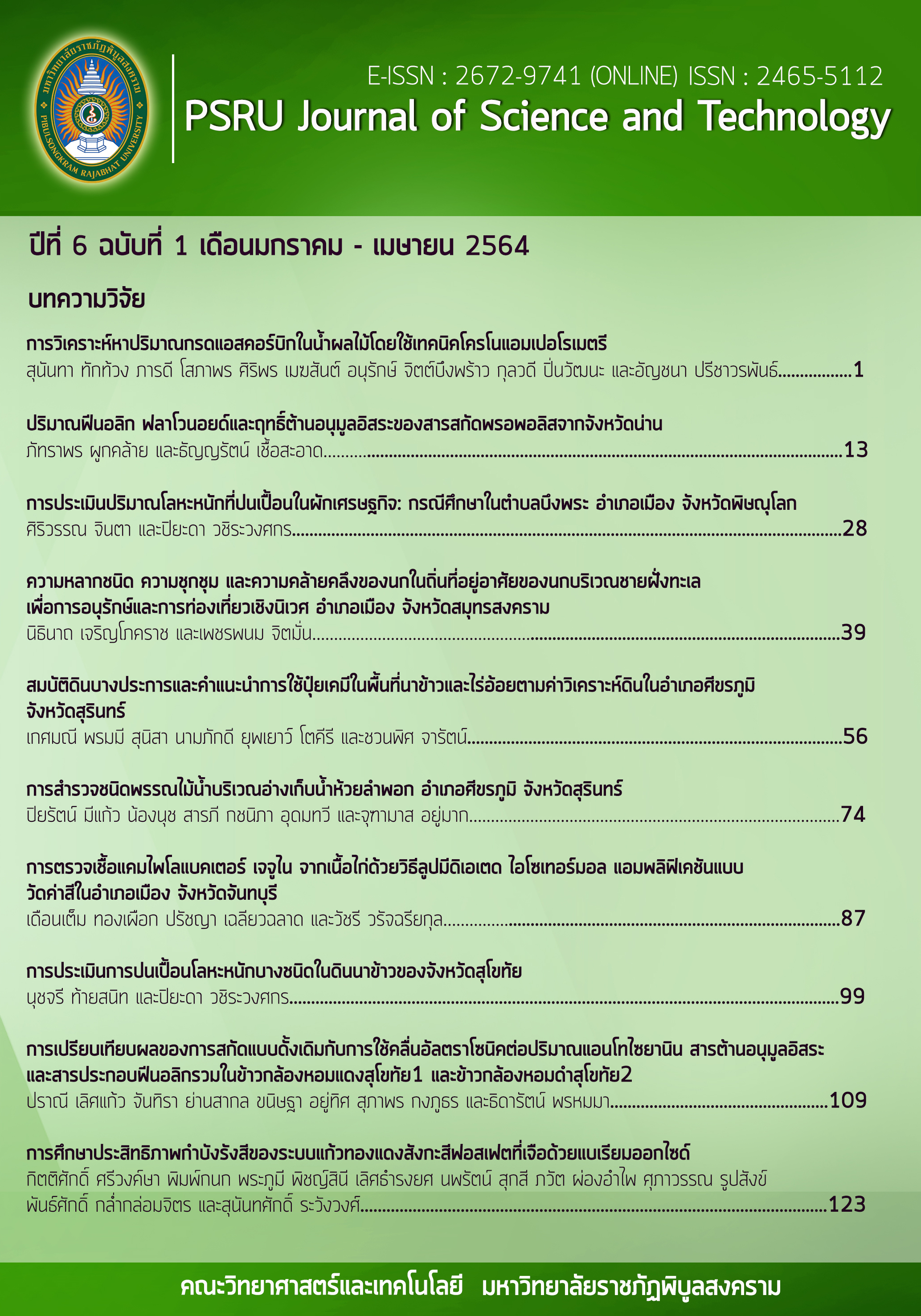DETERMINATION OF ASCORBIC ACID IN JUICES USING THE CHRONOAMPEROMETRY
Keywords:
Juice, Chronoamperometry, Ascorbic acidAbstract
The present work aims to determine the amount of ascorbic acid using chronoamperometry by glassy carbon electrode. The Electrochemical behavior and quantitative determination of ascorbic acid was carried out in phosphate buffer solution (pH 6.0). Electrochemical behavior of ascorbic acid has been studied by cyclic voltammetry, which the anodic peak of ascorbic acid was observed at the potential of 0.30 Volt, at scan rate of 0.10 Volt per second. Chronoamperometric detection of ascorbic acid showed the linear response in the range of 10 to 340 micromolar at 0.30 Volt. Moreover, the proposed method was successfully applied to real sample analyze as lemon and orange juices.
References
ฉัตรชัย ยมศรีเคน. (2562) การวินิจฉัยและการรักษาภาวะอ่อนแรงผู้ป่วยโรคขาดวิตามินซี (โรคลักปิดลักเปิด): รายงานผู้ป่วย 2 ราย ในโรงพยาบาลมหาสารคาม. วารสารโรงพยาบาลมหาสารคาม, 16(2), 62-71.
Bazel, Y., Riabukhina, T., & Tirpák, J. (2018). Spectrophotometric determination of ascorbic acid in foods with the use of vortex-assisted liquid-liquid microextraction. Microchemical Journal, 143, 160-165.
Cathcart, R.F. (1991). A unique function for ascorbate. Medical Hypotheses, 35(1), 32-37.
Chammui, Y., Pinwattana, K., & Preechaworapun, A. (2018). A simple method for the determination of gallic acid in Thai herbs by cyclic voltammetry. PSRU Journal of Science and Technology, 4(1), 39-49.
Duzmen, S., Baytak, A.K., & Aslanoglu, M. (2020). A novel voltammetric platform composed of poly (aminopyrazine), ZrO2 and CNTs for a rapid, sensitive and selective determination of ascorbic acid in pharmaceuticals and food samples. Materials Chemistry and Physics, 252, 123170.
Hernández, Y., Lobo, M.G., & González, M. (2006). Determination of vitamin C in tropical fruits: A comparative evaluation of methods. Food Chemistry, 96(4), 654-664.
Kunpatee, K., Traipop, S., Chailapakul, O., & Chuanuwatanakul, S. (2020). Simultaneous determination of ascorbic acid, dopamine, and uric acid using graphene quantum dots/ionic liquid modified screen-printed carbon electrode. Sensors and Actuators B: Chemical, 314, 128059.
Li, Y., Ye, W., Cui, Y., Li, B., Yang, Y., & Qian, G. (2020). A metal-organic frameworks@ carbon nanotubes based electrochemical sensor for highly sensitive and selective determination of ascorbic acid. Journal of Molecular Structure, 1209, 127986.
Nielsen, S.S. (2010). Chapter 7 Food Analysis Laboratory Manual, Food Science Texts Series. Business Media, LLC Springer Science. doi:https://doi.org/10.1007/978-1-4419-1463-7_7
Wang, H., Xiao, L.-G., Chu, X.-F., Chi, Y.-D., & Yang, X.-T. (2016). Rational Design of Gold nanoparticle/graphene hybrids for simultaneous electrochemical determination of ascorbic acid, dopamine and uric acid. Chinese Journal of Analytical Chemistry, 44(12), e1617-e1625.
Wu, S., Sun, T., Wang, H., Fan, Z., Li, L., Fan, B., Liu, L., Ma, J., & Tong, Z. (2020). A sandwich-structured, layered CoTMPyP/Sr2Nb3O10 nanocomposite for simultaneous voltammetric determination of dopamine and ascorbic acid. Journal of Electroanalytical Chemistry, 873, 114403.
Zuo, R., Zhou, S., Zuo, Y., & Deng, Y. (2015). Determination of creatinine, uric and ascorbic acid in bovine milk and orange juice by hydrophilic interaction HPLC. Food Chemistry, 182, 242-245.
Downloads
Published
How to Cite
Issue
Section
License
กองบรรณาธิการขอสงวนสิทธิ์ในการปรับปรุงแก้ไขตัวอักษรและคำสะกดต่างๆ ที่ไม่ถูกต้อง และต้นฉบับที่ได้รับการตีพิมพ์ในวารสาร PSRU Journal of Science and Technology ถือเป็นกรรมสิทธิ์ของคณะวิทยาศาสตร์และเทคโนโลยี มหาวิทยาลัยราชภัฏพิบูลสงคราม และ
ผลการพิจารณาคัดเลือกบทความตีพิมพ์ในวารสารให้ถือมติของกองบรรณาธิการเป็นที่สิ้นสุด







